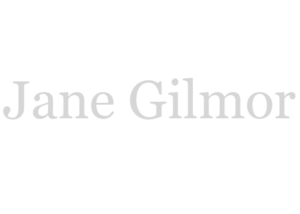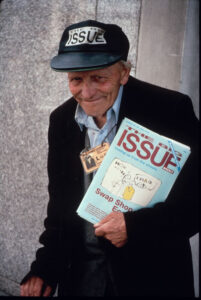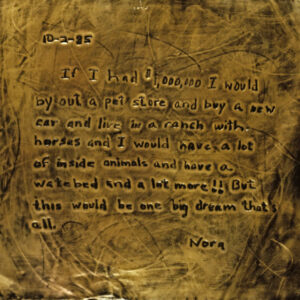My intermedia installations of the late 1980’s to the mid 90’s combined metal relief and text with video, found objects and collected notes and images from those disenfranchised by homelessness, serious illness, and other contemporary social issues. After living in New York City in 1986, my work began to deal with issues of homelessness and loss of identity. In 1987 I started a long-term collaborative project that began at Federal City Shelter in Washington, D.C., headquarters for the activist National Coalition for the Homeless. I continued this project working in shelters and hospitals in the U.S. and U.K. for a decade.
In workshops and journaling we concerned ourselves with those experiences where object, place and identity intersect. During workshops we created drawings and writings on metal foil, often based on a remembered favorite “place”. This remembered “place” or “space” became the physical manifestation for a spiritual concept or a psychological space one might call “home.”
These hundreds of metal notes became part of installations I constructed in storefronts, community centers, alternative art spaces, hospitals and museums. Like the folk art grottos and roadside shrines I began studying in the 1970’s, these collaborative installations are multi-layered. In large rooms, walls, floors and ceilings are covered in metal notes juxtaposed with found objects, metal books, video and elements such as steam, water and light. The largest of these installations were in storefronts in London, U.K., Davenport, Iowa, The Bemis Center for Contemporary Art in Omaha and The Cedar Rapids Museum of Art and YWCA in Cedar Rapids, Iowa.
These workshops and installations were intended to give a voice to the disenfranchised in their own community and beyond. I also hoped to give those participating access to nontraditional art forms and to encourage the use of imagination as a survival tool. All participants were given credit for their work. Any profits went into the project. They usually created one metal note to keep and one similar to it for the traveling installation. Many chose to remain anonymous, but have not been forgotten.
Though my art takes a variety of forms, it is united by my belief that art can help make meaning of one’s experiences. These installations became shrines to the extraordinary nature of “ordinary life.” For me they embody the peculiar, ridiculous and meaningful (less) qualities of everything human.
THANK YOU
I would like to thank the following institutions and individuals in addition to those who participated but have chosen to remain anonymous, but are not forgotten: Federal City Shelter and The National Coalition for the Homeless in Washington, D.C., Sean Turner, John Minx, Mitch Snyder, The Big Issue, the Delphina Foundation, London, U.K, The Virginia Center for the Arts, The Davenport Museum of Art, especially Director Dan Stetson and artist Lloyd Schoeneman, Quad City Arts, Kate Ridge, Miriam House and John Lewis Coffee House in Davenport, and to Sandra Bullock at Neighborhood Place in The Quad Cities: The Cedar Rapids, Museum of Art, especially then curator Leslie Wright, The Cedar Rapids YWCA, The Madge Phillips Center and Women’s Shelter, The Katharine McAuley Shelter and Women’s Center, Rick Edelman, Mathew Butler, Nathan Peck, and, always, David Van Allen. The Bemis Center for Contemporary Art, Omaha, especially then director Ree Schonlau Kaneko and Gregg Narber board member.












